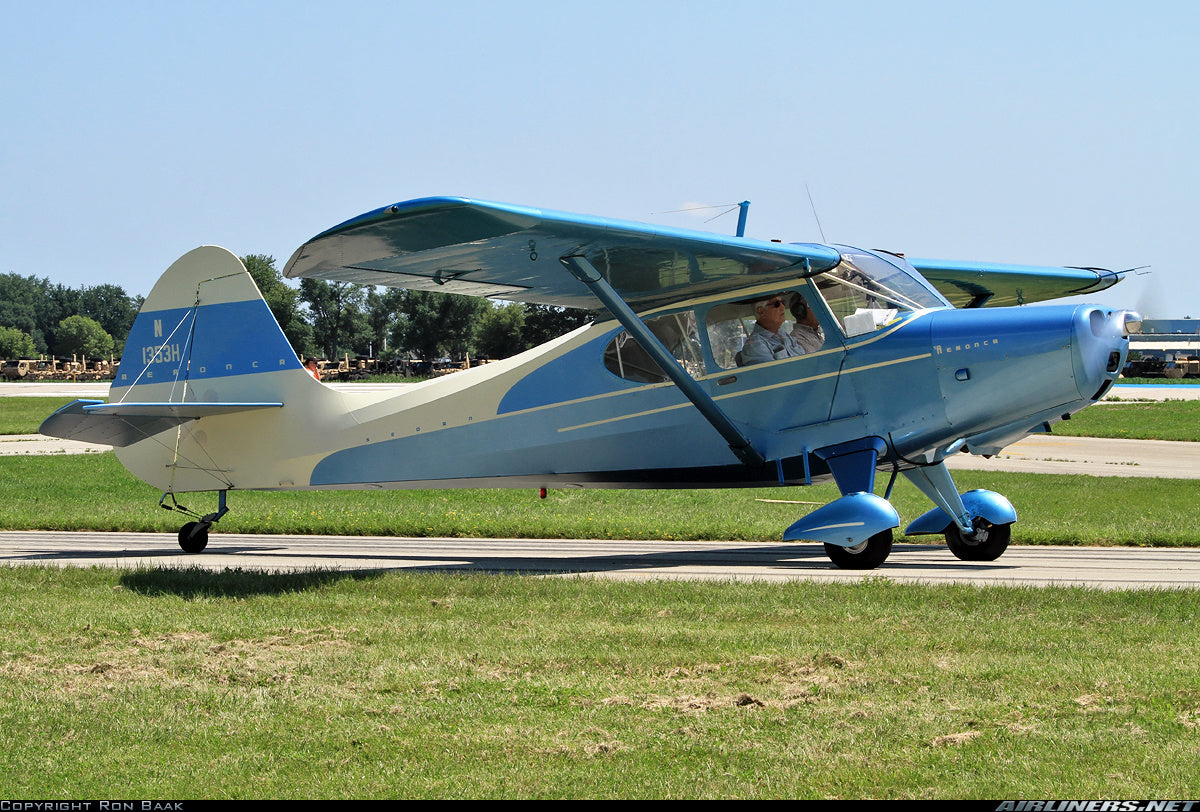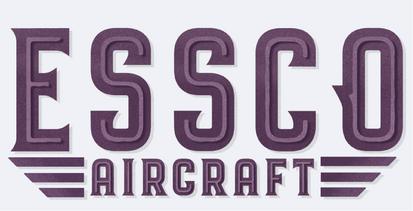
Number 63 of 100 in 100: The Aeronca 15 Sedan 🛩️
Conceptualization:
The Aeronca 15 Sedan was born in a transformative era for aviation. After World War II, the focus shifted from military aircraft production to meeting the needs of the civilian aviation market. The war left behind a growing number of experienced pilots who wanted to continue flying, as well as an expanding public interest in personal and recreational aviation. Aeronca Aircraft Corporation, already known for their lightweight and dependable planes, recognized this demand and set out to create a versatile aircraft that could cater to families, small businesses, and flying enthusiasts alike.
The idea was to design a four-seat aircraft that would be affordable, reliable, and practical for various uses. Aeronca’s vision was to create something bigger than their previous models, offering more passenger and cargo space while still being simple to fly. This strategic move was aimed at competing with contemporaries like Cessna and Piper, which were also innovating in the market. The Aeronca 15 Sedan was created to provide comfort, safety, and versatility for personal travel, recreational flying, and light utility work, positioning itself as a dependable choice in the post-war general aviation landscape.
Original Design:
The original design of the Aeronca 15 Sedan was crafted to be both practical and robust, aligning with the needs of post-war pilots. Aeronca opted for a high-wing configuration, which offered excellent visibility, making it ideal for a range of flying activities. The spacious four-seat cabin was a major departure from Aeronca's earlier two-seat designs, providing ample room for pilots, passengers, or cargo. This setup was particularly appealing to families and small business owners who needed a multi-purpose aircraft.
The landing gear of the Aeronca 15 Sedan was built to withstand operations on grass strips and other unimproved airfields, showcasing its rugged utility. The fixed conventional (tailwheel) gear design added to its simplicity and ease of maintenance. The structure itself combined a metal tube framework for the fuselage and wooden wings, both covered in fabric, striking a balance between durability and weight reduction. Aeronca equipped the aircraft with a 145-horsepower Continental C-145 engine, giving it enough power for efficient short trips and reasonable cruising speeds, all while keeping fuel consumption efficient. The design embodied Aeronca’s commitment to simplicity and functionality, making it a popular choice among pilots seeking reliability without the complications of advanced systems.

Photo Credit: airliners.net - Michael Lovering
Principal Designer:
The design of the Aeronca 15 Sedan was the product of Aeronca’s experienced in-house team, which had already established a reputation for producing successful light aircraft. The company’s design philosophy was heavily influenced by earlier contributions from figures like Jean A. Roche, an engineer pivotal to Aeronca’s formative years and the creation of the Aeronca C-2. This lightweight, practical approach set the stage for Aeronca’s future aircraft.
Leading up to the 15 Sedan, Aeronca had already built notable models like the two-seat Aeronca 7 Champion and the side-by-side Aeronca 11 Chief, both introduced in the mid 1940s. The design team leveraged their experience with these aircraft to create the 15 Sedan, integrating features that would cater to pilots wanting more space and versatility. After the 15 Sedan's production ended in 1951, Aeronca shifted its focus away from complete aircraft manufacturing to concentrate on producing aircraft components and fulfilling military contracts. This transition marked the end of the company’s direct involvement in the light aircraft market but demonstrated their ability to adapt to the evolving industry.
Production Run:
The production of the Aeronca 15 Sedan began in 1948 and ended in 1951. This short production run reflected the post-war aviation boom and its slowdown. During this time, Aeronca managed to produce 561 units, a testament to the aircraft’s popularity within its niche. Initially, the demand was fueled by a general enthusiasm for personal and recreational flying, as well as the return of military pilots looking for reliable civilian planes.
However, by the early 1950s, the market for small aircraft began to cool, influenced by an increase in competition. This led to a decline in production, ultimately resulting in the end of the 15 Sedan’s production in 1951.
Evolution:
The Aeronca 15 Sedan maintained a consistent design throughout its production run, with very few significant upgrades or variants introduced. The aircraft’s original build was simple, so Aeronca didn’t see the need to implement drastic changes during its brief manufacturing period. However, that didn’t stop individual owners and aviation lovers from personalizing their planes over the decades.
Modifications have included engine upgrades, where more powerful or modern engines were swapped in to improve performance. Avionics were also commonly updated by owners over the years to keep up with advances in aviation technology, ensuring that their 15 Sedans remained safe and practical for modern flying. The high-wing design made it adaptable for float and ski operations, which increased its utility in different environments, from remote lakes to snowy fields. These adaptations demonstrated the versatility that Aeronca built into the 15 Sedan’s core design, allowing it to evolve long after the company stopped producing them.

Photo Credit: airliners.net - Mick Bajcar
Specifications:
Aeronca 15AC Sedan Specifications:
General characteristics:
- Crew: 1
- Capacity: 3 passengers
- Length: 25 ft 3 in (7.70 m)
- Wingspan: 37 ft 6 in (11.43 m)
- Height: 7 ft 0 in (2.13 m)
- Wing area: 200 sq ft (18.6 m2)
- Airfoil: NACA 4412
- Empty weight: 1,150 lb (522 kg)
- Gross weight: 2,050 lb (930 kg)
- Fuel capacity: 40 US gal (33 imp gal; 150 L)
- Powerplant: 1 × Continental C-145 six-cylinder horizontally-opposed air cooled engine, 145 hp (108 kW)
Performance:
- Maximum speed: 129 mph (208 km/h, 112 kn)
- Cruise speed: 114 mph (183 km/h, 99 kn) at sea level (75% power)
- Stall speed: 53 mph (85 km/h, 46 kn) (power off)
- Range: 456 mi (734 km, 396 nmi)
- Service ceiling: 12,400 ft (3,800 m)
- Rate of climb: 800 ft/min (4.06 m/s)
In Comparison to Other Aircraft in its Class:
When lined up against its peers from the late 1940s, the Aeronca 15 Sedan held its ground as a solid, versatile aircraft with a unique balance of power, capacity, and reliability. The Piper PA-14 Family Cruiser, with its 115-hp Lycoming O-235 engine, offered a similar range and seating for four but lagged slightly in cruise speed and power compared to the 15 Sedan. The Cessna 170, powered by the same 145-hp Continental C-145 engine as the Aeronca, boasted a higher range of 514 nautical miles, making it an excellent choice for longer trips. It also featured more refined avionics and a smoother design. Meanwhile, the Luscombe 11 Sedan, with a 165-hp Continental E-165 engine, exceeded the Aeronca’s cruising speed and range. Overall, the Aeronca 15 Sedan was appreciated for its straightforward, fabric-covered metal tube construction that was not only lighter but also simpler to maintain, making it ideal for pilots flying in more remote or rugged conditions where durability and easy repair were prized.
Performance:
V-Speeds:
- Vne (Never-Exceed Speed): 140 mph (225 km/h)
- Vno (Maximum Structural Cruising Speed): 120 mph (193 km/h)
- Va (Design Maneuvering Speed): Approximately 95 mph (153 km/h)
- Vso (Stall Speed): 53 mph (85 km/h)
- Best Rate of Climb (Vy): Approximately 70 mph (113 km/h)
- Best Angle of Climb (Vx): Approximately 60 mph (97 km/h)
G Load Limitations:
- Normal Category:
- Positive G Limit: +3.8
- Negative G Limit: -1.52
- Utility Category (when applicable and with restrictions):
- Positive G Limit: +4.4
- Negative G Limit: -1.76
Performance Assessment:
The Aeronca 15 Sedan proved to be an excellent choice for both training and personal aviation, thanks to its balanced and forgiving design. For training purposes, the aircraft’s stable flight characteristics and high-wing configuration offered students and instructors great visibility and a safe learning environment. When it came to personal use, the 15 Sedan shone as a reliable four-seater ideal for short to medium cross-country flights. Its reasonable cruise speed and low stall speed made it suitable for operations on smaller or unimproved airfields, while its rugged landing gear ensured durability and confidence for recreational pilots flying in rural or challenging environments. Although not specifically designed for utility work, the aircraft’s adaptability for float and ski modifications expanded its role, making it a favorite for outdoor enthusiasts needing access to remote locations for activities like hunting or fishing. The Aeronca 15 Sedan’s performance was a reflection of its post-war design philosophy: practical, safe, and versatile enough to support pilots transitioning to civilian flying, whether for training, personal use, or light utility work.

Photo Credit: airliners.net - Fred Seggie - WorldAirImages
Safety Record:
The Aeronca 15 Sedan has held a good safety record over the years, largely due to its straightforward design and stable flying characteristics. However, like any aircraft of its age, it has some safety considerations. One of the main concerns revolves around engine performance, particularly as it relates to vintage engines like the Continental C-145. Maintenance is key to preventing issues, as aging engines can suffer from typical wear and potential reliability problems if not well cared for.
Structural integrity is another point of attention. The metal tube fuselage and wooden wing components require thorough inspections to check for signs of corrosion and fatigue, which are common in older aircraft. The tailwheel landing gear, while sturdy, does require pilots to have solid tailwheel skills to avoid ground loops and hard landings, particularly on less-than-ideal runways. Despite these factors, the 15 Sedan’s safety record holds up well compared to the Piper PA-14 and the Cessna 170, which share similar operational challenges. With proper maintenance and skilled piloting, the Aeronca 15 Sedan remains a reliable and cherished aircraft.
Acquisition Cost:
When the Aeronca 15 Sedan first hit the market in 1948, it was priced at approximately $4,395—a reasonable cost at the time for a four-seat aircraft that offered versatility and reliability. This affordability was one of its key selling points, making it accessible to a range of pilots, from recreational fliers to small business owners. Over the decades, the value of these aircraft has increased as they’ve become classics in the vintage aviation community.
Today, the cost for an Aeronca 15 Sedan can vary based on its condition, modifications, and maintenance history. Current market values typically range from $56,000 to $125,000 for well-maintained or restored examples. This reflects the aircraft’s enduring appeal and its status as a practical, enjoyable classic plane.
Conclusion:
The Aeronca 15 Sedan embodies the spirit of post-war aviation, bridging the gap between practicality and affordability. Created to meet the needs of a shifting aviation market, it provided a reliable and versatile platform for personal and utility flying. Its high-wing design, spacious four-seat cabin, and straightforward performance made it a trusted companion for pilots across the country. Although its production run ended in 1951, the 15 Sedan's legacy has endured, cemented by its ongoing use and admiration in the aviation community.
The aircraft's enduring appeal lies in its combination of simple maintenance, stable flying characteristics, and adaptability to various flying conditions. While there are common concerns tied to its age—such as engine reliability and structural integrity—these are well-managed through diligent maintenance and experienced piloting. With a solid safety record and a market value that reflects its vintage charm, the Aeronca 15 Sedan remains a beloved choice for those who appreciate the classics.

Photo Credit: airliners.net - Andre Wadman
Bibliography:
Wikipedia – Aeronca 15AC Sedan
Essco Links:
